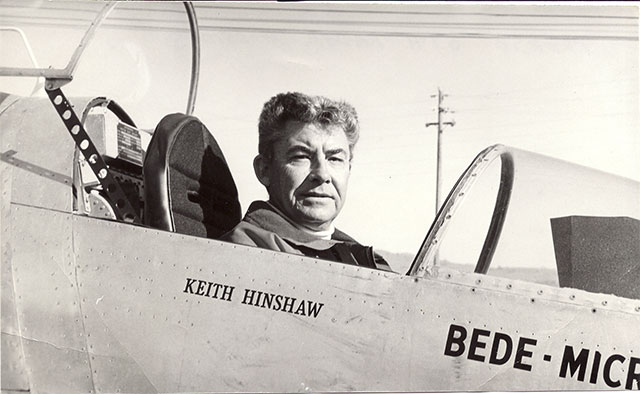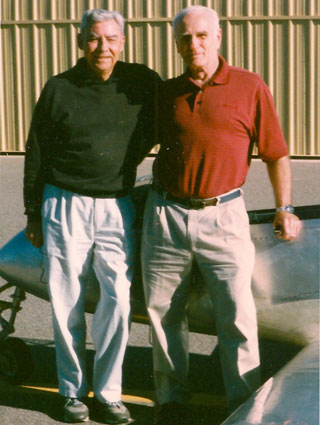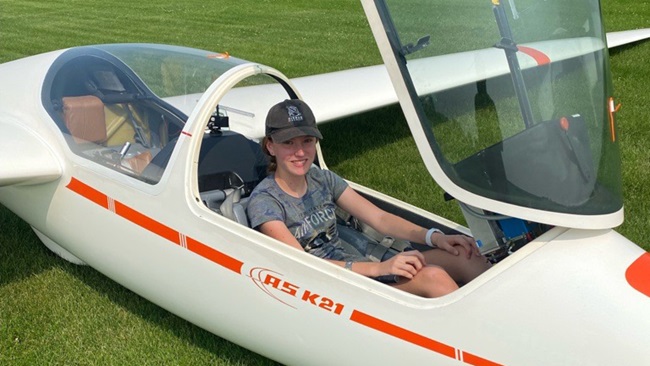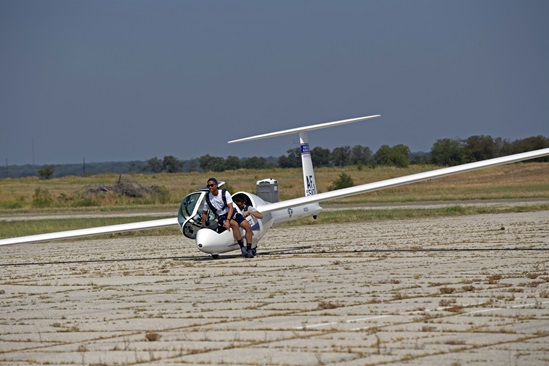
Only a few hundred kits have ever made it in the air, and many of those pilots had Keith Hinshaw to thank. Bede Aircraft Inc. struck a chord, and was overwhelmed by orders soon after the tiny, single-seat BD-5 was introduced to the world at the 1970 EAA convention in Oshkosh, Wis.
Wildly popular but plagued by rotten luck—the engine manufacturer went bankrupt just before the first production engines were to be delivered, for example—the BD-5 left its authors bankrupt and the dreams of thousands in shambles.
 Keith Hinshaw, left, seen with BD-5 owner John Lewis after Lewis completed his first solo in the single-seater in 2003. Hinshaw helped many builders complete their BD-5 kits and learn to fly the aircraft, filling a void left by the bankruptcy of Bede Aircraft Inc. Photo courtesy John Lewis.
Keith Hinshaw, left, seen with BD-5 owner John Lewis after Lewis completed his first solo in the single-seater in 2003. Hinshaw helped many builders complete their BD-5 kits and learn to fly the aircraft, filling a void left by the bankruptcy of Bede Aircraft Inc. Photo courtesy John Lewis.
Hinshaw, a Bede dealer in San Jose, Calif., when the company went under at the close of the 1970s, took upon himself the mission to keep hope alive for a community of builders who were determined to find or fabricate the parts needed to finish their incomplete kits and make them fly. The committed aviator died Jan. 4.
The Smithsonian National Air and Space Museum notes, in a description of the BD-5 in its collection,that, “Hinshaw and his staff worked out a nifty solution to the propulsion problem when they successfully adapted a turbo-charged Honda automobile engine to the aircraft.”
Hinshaw would remain the linchpin of the BD-5 community for decades to come. He was capable and enthusiastic, and “almost by default became the clearinghouse,” said Ed “Skeeter” Karnes, a kit customer who ultimately bought Hinshaw’s Bede-Micro Aviation in 1991 and in turn founded BD-Micro Technologies Inc. to produce updated kits (a story described in the December 2012 issue of AOPA Pilot ). Years before the BD-5 became a Coors Light Silver Bullet, landed a movie role as James Bond’s jet, or won military contracts probing national defenses just above the wave tops, Hinshaw effectively rescued the aircraft, Karnes said. “Keith was the mainstay of keeping it alive more than anybody else.”
Hinshaw was skilled in the construction and piloting of the BD-5, whose designer borrowed the nose of a sailplane and set the tiny aircraft just inches off the ground. (Pilots are well advised to get used to flying a glider before attempting the BD-5, in order to acclimate and avoid flaring high.) Hinshaw logged many hours testing newly built BD-5s on behalf of their less-experienced owners. Lewis recalled that Hinshaw was also hired to fly military radar studies, and managed on one memorable mission to nurse a stricken BD-5 back to land after the oil pressure began a steady decline 250 miles offshore, finally dropping to zero just as the wheels touched down.
After selling jigs, specialized tools, and parts to Karnes in 1991, Hinshaw remained a resource for BD-5 builders and pilots around the world, until his death. He was 85, and is survived by his wife, Shirley; their children, Michael and Pattie; 11 grandchildren; and two great-grandchildren. There are 328 BD-5s, including all types, currently registered in the U.S., and several more flying around the world.



